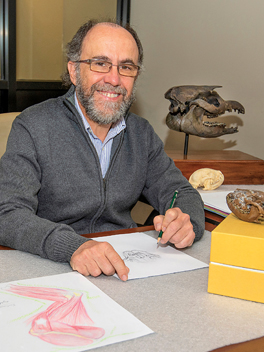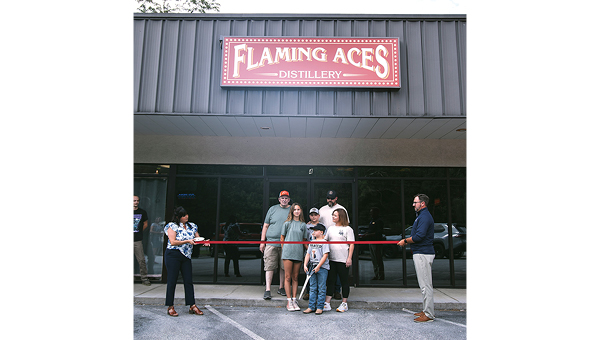Making the past come alive through art and science: Paleoartist Mauricio Antón is Basler Chairholder at ETSU
Published 8:31 am Tuesday, February 11, 2020

- Contributed Photo Mauricio Antón at work in the ETSU Museum of Natural History at the Gray Fossil Site.
JOHNSON CITY — World-renowned paleoartist Mauricio Antón is in residence at East Tennessee State University this spring as the chairholder of the Wayne G. Basler Chair of Excellence for the Integration of the Arts, Rhetoric and Science.
Created in 1994, the Basler Chair of Excellence brings a variety of scholars to the community to broaden learning opportunities for ETSU students and the general public in the arts, humanities and science. It is named in honor of a longtime member of the ETSU Foundation who is a strong advocate of programs at the university and has a deep commitment to the liberal arts.
Antón, who hails from Spain and was raised in Venezuela, specializes in the scientific reconstruction of extinct life and is well-known for his influential paintings of early humans, extinct carnivores and other vertebrate fossil groups. He is also one of the world’s foremost experts on saber-toothed cats.
Trending
Classically trained in the fine arts, Antón became a paleoartist — and eventually a paleontologist — by traveling the world and not only drawing today’s animal species but also studying their anatomy and behavior and applying that scientific knowledge to species of the past.
“Mauricio is the primary ‘go-to’ person on how we reconstruct what animals looked like in the past,” said Dr. Blaine Schubert, professor of Geosciences and director of the ETSU Museum of Natural History at the Gray Fossil Site. “What that takes is a deep understanding of anatomy and observation of living forms. He travels to Africa and other places in the world to watch animals in the wild, study their behaviors, and sketch them. Mauricio also does dissections to understand how muscles and other soft tissues relate to skeletal form and function. Using modern animals as a foundation, he then fleshes out fossil organisms so we can imagine how they may have appeared and behaved.”
Antón is sought after by researchers, museums and publishers for his work, and he is the author and co-author of numerous books and articles. He has had illustrations published in many scientific articles and popular magazines, including National Geographic; has produced and participated in scientific films and documentaries; developed exhibits for major natural history museums, including the American Museum of Natural History and Smithsonian; won awards for his books; and often gives invited lectures on his work at conferences, museums and universities.
During his time as the Basler Chairholder, Antón is co-teaching two courses with ETSU faculty. These include “Scientific Illustration in Natural History” through the Department of Art and Design and “Anatomy for the Paleoartist” in the Department of Geosciences.
In these courses, students are working with specimens from the ETSU Museum of Natural History and Gray Fossil Site, as well as the departments of Geosciences and Biological Sciences. The students’ work from these classes, along with some of Antón’s work, will be displayed at ETSU’s Slocumb Galleries in late March.
In addition, Antón will give a series of three free public lectures this spring.
Trending
The first, “Bringing Sabertooths to Life: A Case Study in Paleontological Reconstruction,” will be held Wednesday, Feb. 12, at 7 p.m. in ETSU’s Ball Hall auditorium.
Additional talks include “Reconstructing Neanderthals and Other Fossil Hominids: Dealing with Scientific and Social Aspects of Paleoanthropological Art” on Tuesday, March 10, at 7 p.m. in the D.P. Culp University Center’s Martha Street Culp Auditorium, and “First-Hand Study of Extant Animals as a Reference for Natural History Reconstructions: From Dissection to Wildlife Observation” on Thursday, April 9, at 7 p.m. in the Ball Hall Auditorium.
He will also be part of a “living exhibit” at the ETSU Museum of Natural History this spring by working on paleoart projects in a laboratory visible to the public. In this setting, Antón will work closely with ETSU paleontologists on artistically reconstructing the species in which they specialize, including red pandas with Dr. Steven Wallace and short-faced bears with Schubert.
“It is so exciting to give this opportunity to our students to learn from Mauricio Antón,” Schubert said. “We’re hoping he will be — like many of our Basler Chairs are — a big fixture on the campus this spring. Because he is such a ‘Renaissance person,’ he truly does bring together arts and sciences in so many ways, exemplifying the spirit of the Basler Chair of Excellence.”
For more information, contact Schubert at 423-439-7883 or schubert@etsu.edu. For disability accommodations, call the ETSU Office of Disability Services at 423-439-8346.





